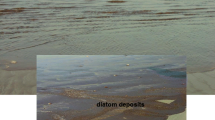Abstract
A 20 month field study was conducted on ammonium excretion rates of the Pacific razor clam Siliqua patula Dixon along the beaches of Washington State, USA. Excretion rates of all those nutrients likely to be regenerated in sufficient quantity to affect surf diatom growth were measured; ammonium appeared to be the most important metabolite. Excretion of ammonium by razor clams far exceeded that by other beach fauna. Ammonium excretion rates of razor clams were positively correlated with shell length, but no correlation between ammonium excretion rate and water temperature was evident. This may be an artifact or may represent some degree of seasonal acclimation of the species to temperature. Weight-specific ammonium excretion rates were negatively related to clam size, indicating a possible large (and unknown) contribution of regenerated ammonium by smaller clams in their first year of growth; smaller clams were rarely captured during this study.
Similar content being viewed by others
Literature Cited
Allen, J.A. and M.R. Garrett: The excretion of ammonia and urea by Mya arenal la L. (Mollusca: Bivalvia). Comp. Biochem. Physiol. 39A, 633–642 (1971)
Bayne, B. L. and C. Scyllard: Rates of nitrogen excretion by species of Mytilus (Bivalvia: Mollusca). J. mar. biol. Ass. U. K. 57, 355–369 (1977)
Davis, C.O., P.J. Harrison and R.C. Dugdale: Continuous culture of marine diatoms under silicate limitation. I. Synchronized life cycle of Skeletonema costatum. J. Phycol. 9, 175–180 (1973)
Hammen, C.S., H.F. Miller and W.H. Geer: Nitrogen excretion of Crassostrea virginica. Comp. Biochem. Physiol. 17, 1199–1200 (1966)
Hartwig, E.O.: Physical, chemical and biological aspects of nutrient exchange between the marine benthos and the overlying water, 174 pp. Ph.D. thesis, University of California, San Diego 1974
Hemmingsen, A.M.: Energy metabolism as related to body size and respiratory surfaces, and its evolution. Rep. Steno meml Hosp. 9, 1–110 (1960)
Hirschhorn, G.: Growth and mortality rates of the razor clam (Siliqua patula) on Clatsop Beaches, Oregon. Contr. Fish Comm Ore. 27, 1–55 (1962)
Hollander, M. and D.A. Wolfe: Nonparametric statistical methods, 503 pp. New York: John Wiley & Sons 1973
Jawed, M.: Ammonia excretion by zooplankton and its significance to primary productivity during summer. Mar. Biol. 23, 115–120 (1973)
Lewin, J.: Persistent blooms of surf diatoms along the Northwest coast. In: Symposium volume. The marine plant biomass of the Pacific Northwest coast, pp 81–92. Ed. by R.W. Krauss. Corvallis, Oregon: Oregon State University Press 1977
—: Blooms of surf-zone diatoms along the coast of the Olympic Peninsula, Washington. IX. Factors controlling the seasonal cycle of nitrate in the surf at Copalis Beach (1971 through 1975). Estuar. cstl mar. Sci. 7, 173–183 (1978)
—, Ching-hong Chen, and T. Hruby: Blooms of surfzone diatoms along the coast of the Olympic Peninsula, Washington. X. Chemical composition of the surf diatom Chaetoceros armatum and its major herbivore, the Pacific razor clam Siliqua patula Mar. Biol. 51, 259–265 (1979)
—, T. Hruby and D. Mackas: Blooms of surf-zone diatoms along the coast of the Olympic Peninsula, Washington. V. Environmental conditions associated with the blooms (1971 and 1972). Estuar. cstl mar. Sci. 3, 229–241 (1975)
Newell, B.S., B. Morgan and J. Cundy: The determination of urea in seawater. J. mar. Res. 25, 201–202 (1967)
Saijo, Y. and O. Mitamura: Regeneration of nutrients in the waters of a coastal oyster bed. In: The ocean world, pp 242–248. Ed. by M. Uda. Tokyo: Japan Society for the Promotion of Science: 1971 (Proc. jt oceanogr. Assem Tokyo, 1970)
Srna, R.F. and A. Baggaley: Rate of excretion of ammonia by the hard clam Mercenaria mercenaria and the American oyster Crassostrea virginica. Mar. Biol. 36, 251–258 (1976)
Tegelberg, H.C.: Growth and ring formation of Washington razor clams. Fish. Res. Pap. St. Wash. 2, 69–103 (1964)
— and C.D. Magoon: Growth, survival and some effects of a dense razor clam set in Washington. Proc. natn. Shellfish Ass. 59, 126–135 (1969)
Weymouth, F.W. and H.C. McMillin: Relative growth and mortality of the Pacific razor clam (Siliqua patula Dixon) and their bearing on the commercial fishery. Bull. Bur. Fish., Wash. 46, 543–567 (1930)
Author information
Authors and Affiliations
Additional information
Communicated by N.D. Holland, La Jolla
Contribution No. 1048 from the Department of Oceanography, University of Washington, Seattle, Washington 98195, USA.
Rights and permissions
About this article
Cite this article
Lewin, J., Eckman, J.E. & Ware, G.N. Blooms of surf-zone diatoms along the coast of the Olympic Peninsula, Washington. XI. Regeneration of ammonium in the surf environment by the Pacific razor clam Siliqua patula . Mar. Biol. 52, 1–9 (1979). https://doi.org/10.1007/BF00386852
Accepted:
Issue Date:
DOI: https://doi.org/10.1007/BF00386852




